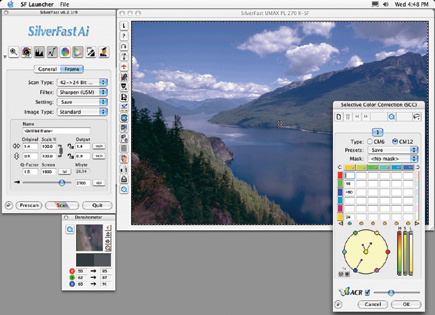UMAX’s PowerLook 2702 Film Scanner; Affordable, And Great, 35mm Scan Quality
Writing about the latest and greatest products is exciting fun. When a really good product comes along with a price just about everyone can afford, that's much more than just fun--it is all too rare. In the past it seemed to be difficult to find a 35mm film scanner with good hardware performance, excellent software support, and a very modest price. But UMAX Technologies, Inc. has put together a package of hardware with specs that support the aspirations of most photo enthusiasts, and combined it with the best professional level software, LaserSoft's SilverFast Ai 6, at an easily affordable $299, which also includes Adobe Elements 2.0. How, you might ask, can such a scanner perform well and be so economical?
|
|
|
The UMAX PowerLook 2702 has specifications and physical capabilities that are now standard but not long ago were at the top of the performance curve. With a resolution of 2700dpi and a 3.4 D-max, it provides potential file sizes for prints as large as consumer photo inkjet printers can reproduce and a dynamic range that more than covers the density range of all slide films. This should make the scanner ideal for most digital darkroom enthusiasts. But specifications are just a part of the story. The hardware and software should be able to work together and perform consistently to make any price, even an economical one, worth it.
Using The New UMAX PowerLook 2702
Getting the scanner set up and the software installed was easy and simple. Usually
35mm film scanners come with native manufacturer's software, and if you're
lucky, LaserSoft SilverFast thrown in to enhance the bundle. With this UMAX
PowerLook 2702, the only software is SilverFast, and with it you have the option
of installing it as a Photoshop plug-in (Adobe Photoshop Elements 2.0 is a part
of the package), or as a stand-alone application--or you can install both
options. Regardless, installation is just a few clicks and it is done.
|
|
|
Beginning with slides I loaded the carrier, which secures the alignment and position of all four slides it holds quite well. But the slide carrier is not as easy to use as some others, although UMAX must be commended for providing two slide carriers with the scanner, one for standard paper mounts and the thin plastic Pakon types, and another carrier for the thicker professional hinged mount types made by Gepe and Wess Plastics. Some, like I did, will notice that the slide carrier and the PowerLook 2702 chassis is apparently the same as used by some other brands. But that is really no indication that what is inside is the same. It's like modern autos where many makes and models share the same components with many other makes and models.
|
|
|
Then, with the carrier loaded, I started LaserSoft SilverFast Ai 6, and first
went to the Options screen to set up my preferences, including Color Management,
of course. But then I was stopped because without any native scanner driver,
a generic manufacturer's profile for the scanner was not installed. Nor
was an IT-8 QC-60 reference slide provided to calibrate and profile the scanner
(calibration and profiling is a built-in capability of SilverFast Ai 6). Fortunately,
I had a fairly current IT-8 reference slide, so in just a few minutes I was
able to calibrate and produce a custom profile for the scanner. (From this experience
I would suggest anyone purchasing the scanner should consider going to the SilverFast
website, www.lasersoft.com,
and ordering a 35mm IT-8 slide to profile the scanner.) I then finished defining
my preferences, and was ready to begin scanning.
Starting with my first scan's color correction adjustments I noticed all
the familiar tool dialogs worked as usual with SilverFast. Getting to one of
the last step settings--choosing the level of USM (unsharp masking) with
the high magnification comparison dialog window open--I was able to work
with the PowerLook 2702 autofocus function and found it quite effective. Just
a modest level of USM sharpening was required to obtain as crisp a final scan
as is needed. (You can always add some sharpening post scan in Photoshop, but
if you apply too much as part of the final scan you just about have to go back
and make another scan with reduced sharpening.)
Once sharpening is set, the final setting, considering the PowerLook 2702 does
not include Digital ICE, is to use SilverFast's ACR to selectively identify
and remove any dirt or scratches. I found SilverFast ACR unusually easy to use
with this scanner in adjusting the Intensity and pixel size to visually mark
and identify the bits of dirt, dust, and defects in the image. Looking at the
result of this first scan I was also pleased to see the ACR cleanup was pretty
thorough and effective, in fact much more so than using ACR with some of the
latest higher resolution 35mm scanners I tested.
|
|
|
With one pretty good scan under my belt, I proceeded to scan all of the slides
I had selected, one after another. And, as I progressed I got better and better
results, producing really quite good final scan images from film originals that
required a lot of correction and adjustment. I was becoming increasingly pleased
with the scanner, and also gratified that this good experience confirmed a theory
I have long held. And that is, good quality scanning is as much the product
of good software, in this case SilverFast Ai 6, as it is attributable to hardware
performance.
- Log in or register to post comments





































